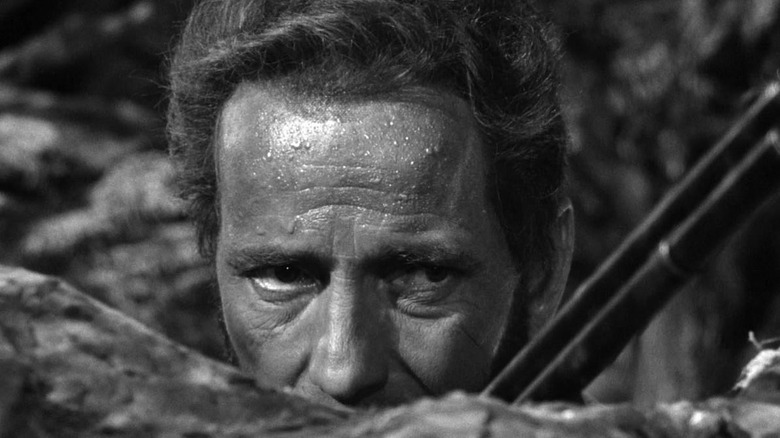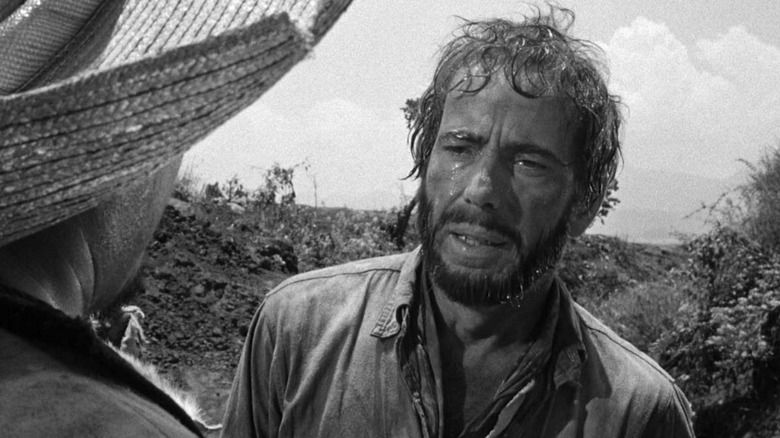Humphrey Bogart Wanted A Much Bloodier End To The Treasure Of The Sierra Madre
We may receive a commission on purchases made from links.
"Nobody puts one over on Fred C. Dobbs." In John Huston's 1948 classic "The Treasure of the Sierra Madre," Fred C. Dobbs is played by Humphrey Bogart in one of the many collaborations between the pair — Huston's crime noir "Key Largo," also starring Bogart, would drop the same year. The role of Dobbs, an everyman poisoned by the precious coinage metal, was perfect for the American actor, whose star was continuing to rise in the same decade that saw his performances in "The Maltese Falcon," "Casablanca," and "The Big Sleep." Ann M. Sperber's comprehensive biography "Bogart" captured his vibe at the time:
"Whether in a white dinner jacket or in a trench coat and a snap-brim fedora, he became a new and timely symbol of the post-Pearl Harbor American: tough but compassionate, skeptical yet idealistic, betrayed yet ready to believe again, and above all, a potentially deadly opponent."
Fred C. Dobbs is certainly that deadly opponent, when he perceives that he is being double-crossed. He begins "The Treasure of the Sierra Madre" down on his luck, begging an American businessman (John Huston, in an uncredited cameo) for money in the Mexican town of Tampico. It's 1925, and times are hard — they're a lot harder without cash flow. So when the opportunity arises to prospect for gold in the remote Sierra Madre mountains, Dobbs, along with Bob Curtin (Tim Holt) and old man Howard (Walter Huston), embark on a quest for treasure.
But Howard knows what gold does to men's souls. As the elements, bandits, and pure unfiltered greed weigh on these three men during their prospecting, it's Dobbs who breaks under the pressure. In one of Bogart's greatest performances, Dobbs grows more paranoid and aggressive by the minute until he is a near-feral shell of a man and meets a nasty end, cut down by Gold Hat (Alfonso Bedoya) and robbed. The scene is a truncated one with mere hints of the brutality originally depicted in B. Traven's 1935 novel, one that the censors of 1948 wouldn't allow. Bogart wanted his character to die as he did in the book, such that Warner Bros. released a statement expressing the actor's disappointment that the scene "couldn't be shown in all its graphic glory."
How it could have happened
Dobbs' death was a casualty of the Motion Picture Production Code. Huston's adaptation originally stayed more accurate to Traven's novel, which included an onscreen decapitation. The scene that audiences know is one where, after a tense standoff, one of Gold Hat's gang stuns him with a rock to the head and Gold Hat himself strikes an off-camera Dobbs twice with his machete. It's a repeat shot of the same blow because Huston was forced to make do when the censors lost their minds over what they originally saw, which was a dummy head of Humphrey Bogart rolling into a nearby water hole. Gold Hat's accomplices can clearly be seen reacting to the head as it rolls away, and the following shot shows the water rippling from the impact, sans head.
The Motion Picture Production Code was still in full swing in 1948, though the rise of television would soon put a strain on the film industry that would inspire the rise of violence and sex on film. But in the code's heyday, scenes of gruesomeness were snuffed or chopped to bits before they could be shown to moviegoers. Because censors would not abide a decapitation in one of the movie's most important scenes, Huston had to deploy some sleight-of-hand. The cut shot of Dobbs' head rolling away was replaced with a repeat shot of Gold Hat hitting an obscured Dobbs. Reportedly, Bogart's reaction to the cut footage was: "What's wrong with showing a guy getting his head cut off?"
Production Code aside, a severed head would have further underlined the film's bleak irony: Gold Hat and his men mistake Dobbs' bags of gold dust for sand, and scatter it all to the wind after killing him. But "Treasure of the Sierra Madre" is plenty brutal all on its own, treating the obsession with riches as a tumor, with Dobbs being the most malignant of the trio. Cut him down, and the gold comes back home to the land it came from.

